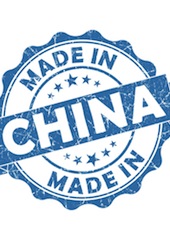Relax! China Isn’t Taking Over the World (Yet)
Will Chinese products soon put everyone else in the rest of the world out of a job?
June 4, 2013

Around the world, anxious questions are being asked about China. Here are the two biggest ones:
What will happen to life in the developed world when China goes beyond clothing, furniture and electronics processing to master the art of making luxury vehicles, airplanes, high-grade weaponry and satellites?
How can developed countries compete when the mainland applies its famous combination of state-subsidized capital and cost-led productivity to pharmaceuticals, biotechnology and component design?
Well, guess what? In most areas, China has already done so … or soon will.
The full spectrum of vehicles from knock-down motorbikes to Mercedes Benz sedans is now manufactured domestically.
The mainland is also rapidly rejuvenating its passenger airline and shipbuilding industries.
Virtually every part of the global civilian (and increasingly military) communications production chain touches on its shores — and even the recent China hacking scare is a testament to its increasingly sophisticated capabilities.
Which is why Chinese products are now putting everyone else out of a job, right?
Errr … not so fast. That’s not how it works.
China may now be able to make and do whatever it wants at home. But when we look at how it trades with the rest of the world, it’s still very specialized at the lower end of the spectrum. And that will probably be so for a long while to come.
The global manufacturing ladder
This goes right back to the very origins of international trade theory, when David Ricardo first expounded the principle of comparative advantage 200 years ago.
Ricardo’s fundamental insight was that it doesn’t necessarily matter how “good” you are at making product A. When countries trade, what matters is how good they are at making product A compared to making product B.
Or, broadly put, each country will export the things it can make the cheapest relative to everything else it produces.
To see how this works in practice, forget about the mainland for a moment and turn instead to the original Asian “tiger” manufacturing economies: Korea and Taiwan.
When they started to become part of the global economy, both economies started out very short on raw materials and productive capital, but with significant amounts of underemployed labor.
Sure enough, for the first 15 years or so, they built a growing net export specialization in low-end labor-intensive products. They also had sizeable imports of commodities and heavy industrial goods.
Then, as rising labor costs (and the opening of ASEAN and China) began to push them out of low-end manufacturing in the 1980s, they moved on to the next rung on the ladder: electronics assembly and processing.
This area had a somewhat higher level of value added and greater capital requirements, while still using significant amounts of labor.
Accordingly, for Korea and Taiwan, the next 10-15 years were about sharply declining net light manufacturing exports, offset by a rapid rise in electronics and IT export market share.
It wasn’t until the late 1990s, when average incomes had reached OECD levels and when low-end manufacturing industries had truly disappeared, that these two countries started to build up a consistent net export position in capital-intensive heavy industry.
They also moved into the higher value-added segments of the IT space as well.
In climbing the rungs of the global manufacturing ladder, Korea and Taiwan specialized in traditional light manufacturing until the moment when capital deployed per worker reached 20% of the global average.
Then they turned to a strong specialization in IT and electronics goods (at various levels of processing intensity). They focused on these sectors until their capital per worker ratio reached 60% of the rest of the world.
It was only at that point that they truly began competing as exporters of capital-intensive products.
The lessons here, for China and the world at large, is that you don’t do everything at once. Rather, a country tends to climb the rungs one at a time.
And this process doesn’t necessarily have much to do with domestic capacity in individual sectors and industries. Rather, it has to do with underlying relative structural endowments.
Is China different?
On the face of it, China is a very different case. It is a far larger and more diverse economy – and one with aggressive state policies.
These are simultaneously aimed at pushing technology transfer, lowering the effective cost of capital and developing domestic capacity across the entire productive space, including most advanced industries.
In other words, China already can or soon will be able to “make everything.” Why then isn’t it a much greater threat to the world’s developed countries?
Let’s look at China’s path of progress, keeping the pattern previously exhibited by South Korea and Taiwan in mind. It should look familiar.
- Since the mid-1980s, China spent 15 years building a specialized franchise in low-end labor-intensive products, while importing capital goods.
- Over the next decade the economy has shifted into a greater specialization in IT and electronics processing, against growing imports of resources and commodities.
- China now faces an environment of rising labor costs, gradually falling light manufacturing surpluses, steady value-added gains in the electronics sector and very little further action on capital-intensive production.
This is just what we saw in the “tigers” before it. China may be a very different economy at home, but from a net trade perspective, it looks very much like Korea and Taiwan circa the mid-1980s.
So it’s a case of climbing the rungs again. It is no accident that China sits almost exactly in the traditional spot along the capital-labor timeline.
The Chinese embedded capital stock per worker at the end of 2011 stood at around 20% of that of its global trading partners — much where Korea and Taiwan found themselves in the early 1980s.
The bottom line is simple. Forget about everything China “can do” on the ground at home.
On a comparative advantage basis, this remains a profoundly labor-intensive, capital-scarce economy, and that is still how it trades with the rest of the world.
And if history is any guide, it will be another couple of decades before the mainland really begins to trade like an advanced economy.
China is coming … but not that fast.
